- Anterior chamber
- Cornea
- Suspensory lig.
- Ciliary body
- Sclera
- Choroid
- Vitreous chamber
- Optic disc
- Retina
- Lacrimal gland
- Eyelid
- Pupil
- Iris
- Lens
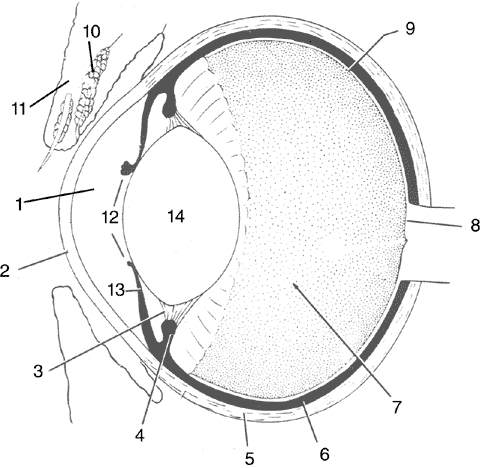
BUY THIS MANUAL NOW and have access to this article and 100's of others just like it!
View some of the 15+ Video clips found in the Feline Manual
basic anatomy and terms | nasolacrimal duct system | proptosis of the eyeball | glaucoma | entropion | ectropion | bilateral protrusion of the third eyelid | prolapsed gland of the third eyelid | blepharitis | tumors of the eyelid | conjunctivitis | abrasions, lacerations | keratitis | lenticular sclerosis | cataract | luxation and subluxation of the lens | anterior uveitis | feline generalized retinal atrophy | hypertensive retinopathy | feline central retinal degeneration | cancers | eye medications
Introduction: It is important to examine the eyes of a pet on a routine basis. Repeated examination allows one to become familiar with the normal appearance of the eye, so any abnormalities will be noticed immediately. Signs of an eye problem vary tremendously and may include cloudiness, tearing, squinting, discharge, redness, blinking, swelling, an increase in blood vessels, or changes in the size or shape of the pupil. Cats may paw at the eye or rub it in an attempt to relieve irritation and itching. Any change in the eye or surrounding tissue may signal a problem and should be a cause for concern.
Many different problems can result in the same set of disease signs, so diagnosis cannot be made by clinical signs alone. Physical examination and special tests are needed to properly identify the cause of the problem. Tests may include a fluorescein dye test, a test for tear production called a Schirmer test, tests to measure pressure within the eyeball, and ocular examination with different types of lenses. The eye may be dilated to allow for proper visualization of the back of the eye.
Eye problems should be brought to the attention of a veterinarian immediately. Prompt diagnosis and treatment can prevent further eye problems that can lead to loss of sight. In addition, changes in the eyes may be a sign of whole body disease. By immediately identifying and reporting any changes, diseases can be diagnosed early and treatment can begin.
Basic Anatomy and Terms: The eye is protected by upper and lower lids, as well as a third eyelid, called the nictitating membrane. Glands which produce tears are located under the lids. The front portion of the eye itself is covered with a thin, clear covering called the cornea. The remainder of the eye is covered with dense, white tissue, the sclera. The margin of the cornea and the sclera is called the limbus. The episclera is the outside surface of the sclera. The conjunctiva is the tissue which reflects from the inside of the eyelids onto the globe. Glands which produce tears are also located in the conjunctiva.
The iris is the colored portion of the eye; the black open space in the iris is the pupil. Behind the pupil is the lens. The lens is attached to the ciliary body. The back of the eye is covered with a layer of tissue called the retina. The inside of the globe is divided by the lens into two chambers. The forward, smaller chamber is called the anterior chamber. This chamber is filled with a clear fluid called aqueous humor. This fluid is produced by the ciliary body and nourishes the eye while helping to maintain its shape. This fluid is continually produced and drained from the eye. Drainage occurs at the iridocorneal angle, also called the drainage or filtration angle. The larger chamber behind the lens is called the posterior chamber. This chamber is also filled with a clear, thick, gelatinous substance called aqueous humor.
Glossary of Eye Terms:
|
 |
Copyrighted graphic used by permission from Anatomy of Domestic Animals, Sudz Publishing (email: sudzpub@mac.com)
Nasolacrimal Duct System and Lacrimal System
Introduction: The lacrimal and nasolacrimal duct system function together to ensure that the eye is continuously bathed in protective tears and that the tears are removed from the eye. The lacrimal system is responsible for the production of tears. Glands in the eye produce tears that act to lubricate the eye and cornea, protect the eye from environmental debris, supply nutrients to the eye, and wash away irritants. Both the lacrimal glands and the gland of the third eyelid contribute to tear production. After the tears protect and bath the eye, they are drained via the nasolacrimal system. This duct system is responsible for drainage of tears from the inner corner of the eye into the inside of the nose. Health of the cornea and conjunctiva depends on the continuous production of tears and their uninterrupted removal from the eye.
If there is a problem with any part of the system, drainage of tears from the eye may be impeded. If the tears do not drain into the duct system, they will spill over onto the face, creating a condition called epiphora. Signs include wet facial skin and a reddish, rusty stain to the skin and hair near the inner corners of the eyes.
Problems Associated with the Nasolacrimal System
Problems with the Eye and Associated Structures:
Globe or Eyeball
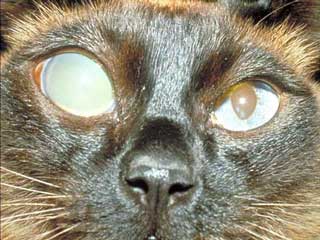 |
|
Acute glaucoma has a rapid onset. The rapid increase in intraocular pressure
results in an extremely painful eye. The pain can cause squinting (blepharospasm)
and epiphora. The cat may resist examination, refuse to eat, be depressed, and
even cry out from the pain. In addition, ocular discharge, redness, and
cloudiness may be noticed.
Diagnosis is based upon examination of the eye and measurement of the pressure
in the globe. Upon examination, the glaucomatous eye may have cloudiness,
corneal edema, redness, and engorgement of the blood vessels in the episclera.
The pupil may be dilated and unresponsive to light. The globe may be enlarged
and firm to the touch. Accompanying problems such as uveitis, a luxated lens, or
neoplasia may be noted. Specific eye examination may show a closure of the
normal drainage area of the eye. The blood vessels in the retina may be
compressed by the increase in pressure. Measurement of the intraocular pressure
will show it to be elevated. Definitive diagnosis is based on measurement of an
elevated intraocular pressure. Acute glaucoma can very rapidly lead to
blindness. Total, irreversible blindness can occur in as little as 24-48 hours.
BUY THIS MANUAL NOW and have access to this article and 100's of others just like it!
Eyelids
Introduction:
Cats have three eyelids. The upper and lower lids help to protect the eye from the environment, distribute tears over the entire eye surface, and control the amount of light that enters the eye. The third eyelid is located in the inner corner of the eye and sweeps across the eye as it closes. It functions to protect and lubricate the eye. It has its own set of tear glands that produce lubricating tears for the entire eye.Problems with the lids can result in pain, swelling, redness, excessive tearing, and abnormal drainage from the eye. Cats with lid pain may rub their eyes, paw at their faces, squint, and show other signs of pain. Problems with the lids can lead to additional problems with closely associated structures such as the cornea, conjunctiva, and nasolacrimal drainage system of the eye. The majority of lid problems that are common in dogs are uncommon in cats.
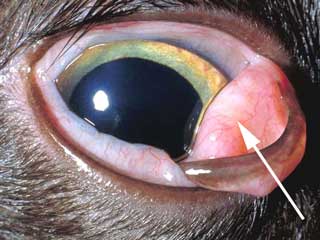 |
|
The condition is diagnosed on physical examination by the appearance of the
red, round to oval mass coming up over the edge of the third eyelid.
Accompanying signs can include squinting, repeated blinking, increased
tearing, and a reddening of the conjunctiva.
Treatment includes topical medications to reduce swelling and irritation,
along with a surgical procedure where the gland is sutured back in place. If
replacement is not successful, the gland can be removed, but removal is
neither the best nor the first method of treatment. Removal of the gland can
result in lack of tear formation that leads to development of corneal and
conjunctival problems. Surgical removal is therefore avoided if it is at all
possible to replace the gland. Topical therapy with anti-inflammatory eye
medication, such as corticosteroids, may be helpful to reduce swelling before
surgery and is important as an aid to help the eye heal after surgery.
BUY THIS MANUAL NOW and have access to this article and 100's of others just like it!
Conjunctiva
Introduction:
The conjunctiva is the membrane that lines the inside of the eyelids and the third eyelid, and covers the outside of the sclera. The conjunctiva is a mucous membrane with an excellent blood supply. It connects the lids to the globe and contains specialized glands. These glands produce the inner layer of the tear film. Problems affecting the conjunctiva may be limited to only the conjunctiva or may involve other portions of the eye. Conjunctival inflammation or disease may also signal illness that affects the entire body. It is important to recognize whether disease processes are limited to the conjunctiva, extend to other parts of the eye, or signal whole body (systemic) disease.
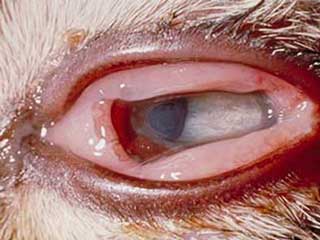 |
|
Conjunctivitis is diagnosed on physical examination. Additional tests are
performed to identify other eye problems and to rule out other eye diseases
that can cause conjunctivitis. These include a Schirmer tear test, fluorescein
dye, intraocular pressure test, bacterial culture and sensitivity, and
conjunctival cytology. Steps are taken to identify any underlying or
accompanying disease situations that contribute to the conjunctival
inflammation.
Treatment involves both medicating the conjunctiva and treating any underlying
or secondary problems. Depending on the cause of the conjunctivitis, treatment
may include topical medications for inflammation and infection, eye washes to
remove discharge, lubricants to add moisture to the eye, and medications to
control infection and inflammation. Topical therapy may include antibiotic
agents, corticosteroids, or combination medications. All discharge should be
flushed from the eye before treatment is attempted to allow the medications to
contact the surface of the eye and the conjunctiva.
Prognosis depends on the underlying cause and severity of the condition.
Simple bacterial conjunctivitis is typically very responsive to treatment with
the appropriate antibacterial medications. Secondary conjunctivitis may not
respond until the underlying cause is identified and treated. Some secondary
conjunctivitis problems may be controlled, but not totally eliminated.
Cornea
Introduction:
The cornea is the outer, transparent layer of the front of the eye. It protects the eye while still allowing light to pass through. The cornea is protected by a layer of tears and by continuously replacing its superficial cells. It lacks blood vessels, and so does not heal easily. Any disease process or insult to the cornea can result in cloudiness (edema), swelling, or pigmentation, which in turn may lead to loss of vision. Corneal irritation or inflammation is extremely painful. It is critical to treat any corneal problem quickly.
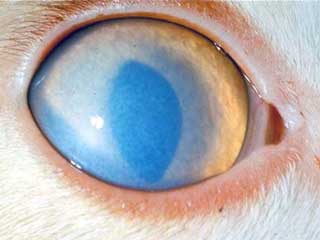 |
|
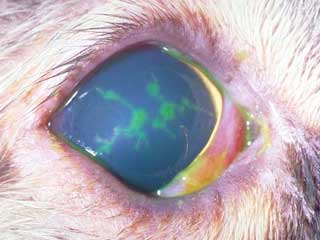 |
|
Diagnosis is based on ocular examination and fluorescein dye testing. If
needed, specific examination of the interior of the eye and cytology can also
aid in the diagnosis. Other tests, such as a Schirmer tear test, are performed
to rule out additional or contributory eye diseases.
Treatment involves elimination of the cause, along with specific treatment
for the ulceration and inflammation. Underlying eye problems, such as
keratoconjunctivitis sicca, entropion, or ectropion, should be treated
appropriately. Treatment of the ulcer may include topical antibiotics to
prevent infection, topical atropine to control pain, specific medications to
control fungal or viral infections, and if indicated, specific medications to
prevent collagen breakdown.
Some ulcers are treated with protective contact lenses. Others may require
surgery to trim (debride) the ulcer edges. Additional surgical procedures
include punctuate keratotomy, conjunctival flaps, and flaps created from the
third eyelid. Proper use of an Elizabethan collar or similar device will help
prevent the animal from scratching the healing ulcer. Eyes should be rechecked
at approximately 3-day intervals; those with deep ulcers should be rechecked
daily until satisfactory healing is observed.
BUY THIS MANUAL NOW and have access to this article and 100's of others just like it!
Lens
Introduction:
The lens focuses light waves that come through the pupil. It is held in place by small suspensory ligaments called lens zonules that attach the lens to the ciliary body. The ciliary body can contract and relax, thereby changing the shape of the lens. The changing shape of the lens allows it to properly focus light waves from different distances onto the retina.BUY THIS MANUAL NOW and have access to this article and 100's of others just like it!
Uvea
Introduction:
The uvea is a very vascular structure that is critical for the maintenance of a healthy eye. It is a pigmented, vascular tunic that sits between the outer fibrous layer of the eye (cornea and sclera) and the inner nervous layer (retina). It is comprised of 3 connected portions - the iris, the ciliary body, and the choroid. The anterior uvea is made up of the iris and the ciliary body. The posterior uvea, located towards the back of the eye, is comprised of the choroid. The iris controls the amount of light that enters the eye. The ciliary body controls the focus of the lens, produces aqueous humor, and helps regulate intraocular pressure. The anterior uvea acts as a blood-aqueous barrier and prevents unwanted particles from the bloodstream from entering the aqueous humor. The choroid provides nourishment to the retina. Most diseases of the choroid are linked to disease of the retina. Because the uvea is highly vascular, it is very reactive to changes in the body and is easily inflamed.Inflammation of the uvea is called uveitis. Specifically, inflammation of the iris and ciliary body is termed anterior uveitis. Posterior uveitis refers to inflammation of the choroid. Inflammation may be limited to only the anterior or posterior uvea, or involve both portions. Inflammation of the uvea allows particles to cross the blood-aqueous barrier and enter the aqueous humor. This causes an inflammatory response in the aqueous which can lead to a loss of vision.
Anterior uveitis: Inflammation of the anterior uvea may occur with several disease conditions seen in the eye. The cause may be external to the eye and include trauma. In addition, anterior uveitis may follow corneal injuries and corneal ulceration. Anterior uveitis can also be caused by infectious agents such as viruses, bacteria, fungi, and parasites. These infections can be limited to the eye or cause disease throughout the body. Common infections in the cat include feline leukemia virus (FeLV), feline infectious peritonitis (FIP), and toxoplasmosis. In addition, certain immune-mediated diseases, cancers of the eye, and exposure to some toxins may lead to anterior uveitis.
Signs of anterior uveitis may include pain, redness of the conjunctiva, corneal edema, red blood cells or white cells in the anterior chamber, epiphora, spasm of the eyelids, and aversion to light. Other ocular changes are specific to anterior uveitis. These include constriction of the pupil, a change in the color of the iris (often darker), swelling of the iris, and enlargement and engorgement of deep blood vessels located in the ciliary body. In addition, inflammatory cells and pigment may clump together and adhere to the cornea, forming small, visible masses called "keratic precipitates." As particles form or flood into the inflamed area, the aqueous humor becomes turbid. This condition is referred to as "aqueous flare." In chronic cases, the iris may actually adhere to the lens, "fixing" the pupil in an unmovable position. This results in a distorted and immobile pupil. Finally, anterior uveitis can be associated with other serious eye problems, including lens luxation, cataracts, ulcerative keratitis, and glaucoma.
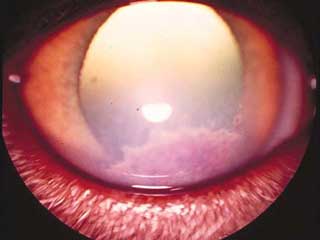 |
|
Diagnosis is based upon complete physical and ocular examination. A thorough eye examination includes measurement of the intraocular pressure. The pressure is typically decreased with uveitis. Additional testing may include blood tests, urinalysis, and radiographs to search for the underlying cause of the disease.
Treatment is aimed at reducing the inflammation of the uvea while determining and eliminating the underlying cause. Anti-inflammatory agents including corticosteroids (1% prednisolone acetate, 0.1% dexamethasone) and non-steroidal anti-inflammatories (flurbiprofen) can be applied topically. Topical medications that dilate the pupil (atropine) are also used. In some cases, corticosteroids can be injected under the conjunctiva or administered systemically. Those patients that do not respond to corticosteroids can be treated with other immunosuppressive drugs, such as azathioprine. Treatment may be altered depending on the cause of the uveitis and the systemic illnesses that are present. Treated animals should be re-examined within one week following the initial treatment and re-evaluated every few weeks.
The animalís prognosis depends on the severity of the uveitis at the time of treatment and the underlying cause of the uveitis. Early, aggressive treatment of the uveitis and the initiating cause is necessary to prevent secondary problems. Prognosis is good if the underlying cause is identified and eliminated, and appropriate eye therapy is instituted. If uveitis is left untreated, glaucoma, lens luxation, and blindness can result. Successful treatment can involve several months of continual medication and follow-up examinations.
* All of the eye pictures were used with permission from Colorado State University Ophthalmology Service.
Retina
Introduction:
The retina is the back portion of the eye. It is considered the "film" that records the visual images that come through the cornea and are focused by the lens. The cells of the retina receive the light images. These cells are of two main types, rods and cones. The rods are sensitive to dim light and the cones are sensitive to bright light. The rods are useful at dusk, while the cones perceive images in the day and help distinguish colors.The rods and cones translate the light images into chemical messages which affect adjacent nerve fibers. The retinal nerve fibers converge together at an area called the optic disc to form the optic nerve. The messages travel as nerve impulses along the optic nerve to the brain where they are again converted into visual images. Any type of damage to the retina will result in interruption of this process and cause loss of vision.
Feline Generalized Retinal Atrophy: If the retina degenerates or atrophies, messages from the eye will no longer reach the brain and blindness will result. Conditions such as vitamin A or taurine deficiency can cause this problem. Retinal atrophy has also been associated with certain breeds of cats (Persians, and Siamese), suggesting that it can be an inherited problem.
With retinal atrophy, early cases may not show many signs. As the retinaís cells degenerate, the cat loses vision. Cats will often lose night vision first, so the animals may have difficulty in dimly lit rooms or at night. This problem can go unnoticed by an owner that leaves on indoor lights until retiring for the evening. Eventually, the retinal atrophy will progress and total blindness will result. An owner may be aware of dilated pupils or a shine from the back of the dilated eye, or may notice nothing until the animal has totally lost vision.
Diagnosis is based upon ocular examination. Pupils will be dilated and not responsive to light. The retinal area will be hyperreflective and retinal examination will show degeneration of the retina and optic nerve, along with changes in the retinal blood vessels and pigmentation. A test called an electroretinography can be performed to measure electrical activity in the retina. The most common treatment options include dietary changes that increase the levels of vitamin A and taurine in the diet.
Hypertensive Retinopathy: Disease and dysfunction of the retina in older cats due to high blood pressure (hypertension) is another cause of blindness. High blood pressure leads to rupture of delicate blood vessels in the retina with separation (detachment) of the retina occurring in some cases. Blood pressure can be difficult to accurately measure in cats. Hyperthyroidism (see page F815) is a common cause of high blood pressure in older cats. If the blood pressure can be effectively lowered with specific medication or proper treatment of hyperthyroidism, some vision may be regained.
Feline Central Retinal Degeneration: This problem is associated with inadequate levels of taurine in the diet. Unlike retinal atrophy, cats that have central retinal degeneration do not have any vision problems and their pupils do not remain dilated. There is some thought that this problem will progress into generalized retinal atrophy. Treatment involves feeding taurine.
Introduction: Cancers may develop in any structure in the eye. They can be found in any age or breed of cat, but are generally more common in older animals. A cancer may be primary and arise from tissue in the eye, or be secondary to a cancer somewhere else in the body. Cancers located anywhere else in the body may migrate (metastasize) to the eye. Tumors may be localized nodules or locally invasive. In addition to occupying space, tumors may cause infection and inflammation of involved tissues. Common eye tumors include adenomas, adenocarcinomas, papillomas, melanomas, histiocytomas, squamous cell carcinomas, and fibromas. Tumors are more likely to be found on the eyelids than any other part of the eye.
A mass in or near the eye will cause signs that reflect the involved area of the eye. For example, a mass on the eyelid can cause signs of blepharitis and conjunctivitis. A mass located on the retina may cause blindness and a dilated pupil. Signs associated with eye disease are not specific to one diagnosis, so ocular examination and diagnostic tests are necessary for proper diagnosis. Diagnostic tests may include special examination, biopsy, histopathology, and MRI testing. Microscopic examination (histopathology) will allow differentiation between inflammation, benign tumors, and malignant tumors. Treatment depends on the type and location of the growth and may include surgical removal, chemotherapy, and removal of the eye. Prognosis depends on the location and type of growth. Early identification and removal of malignant tumors will increase the chances of a successful outcome and reduce tumor spread.
BUY THIS MANUAL NOW and have access to this article and 100's of others just like it!
Eye Medications: Eye medications can be delivered by several methods. Topical medications are applied directly to the eye surface. The topical medications may be available as eye drops and ointments. This method of administration is appropriate for both hospital and home treatment of eye diseases in cats. In addition, veterinarians may administer medications via injection into the eye. Common sites for these injections are subconjunctival (beneath the conjunctiva), retrobulbar (behind the eye), or intraocular (into the eyeball). In addition, diseases of the eye may be treated with medications that are given directly to the cat, either by mouth or by injection. Finally, eye diseases may not be limited to the eyes; they may be a sign of disease that is affecting the entire body. In this case, the veterinarian will prescribe medication to treat the primary illness, as well as to control the problems in the eyes. The following tables list commonly used eye medications.
| CLASSIFICATION/USE/INDICATION | MEDICATION | SPECIFIC USE NOTES | CONTRA-INDICATION (IF ANY) |
| EYE RINSES
USE: Clean, rinse, flush INDICATIONS: Clear mucus before instilling medications, remove debris
from eye |
Sterile, buffered isotonic solutions containing sodium chloride, sodium citrate, sodium phosphate | ||
| Combinations of water, boric acid, zinc sulfate | |||
| EYE LUBRICANTS USE: Lubricate, prevent eye irritation, relieve dryness INDICATIONS: Keratoconjunctivitis sicca, whenever general anesthesia is used, keratitis, ectropion |
Pilocarpine | Irritating, can cause conjunctivitis and worsen uveitis, not commonly used | Can affect respiration and cardiac function |
| Polyvinylpyrrolidone | |||
| Polyvinyl alcohol | |||
| Methylcellulose | |||
| Ethylene glycol polymers | |||
| Refined petrolatum | |||
| Refined lanolin | |||
| Refined peanut oil | |||
| MUCOLYTICS
USE: Prevent collagen break-down, break up mucus INDICATIONS: "Melting" corneal ulcers, chronic conjunctivitis,
keratoconjunctivitis |
Acetylcysteine | Very expensive | |
| Autologous plasma | Sometimes used in place of acetylcysteine | ||
| ANESTHETICS
USE: Topical pain relief INDICATIONS: Minor surgery, eye examination, diagnostic procedures,
preoperative evaluation of entropion, removal of foreign bodies |
Proparacaine 0.5% | Never use therapeutically. May cause corneal irritation. | |
| Tetracaine HCl 0.5%* | |||
| ANTIBIOTICS (SINGLE)
USES: Preparation for an intraocular procedure. Treatment of infection (if possible, select specific agent for microbe; if testing is not possible, broad spectrum or combination antibiotic is preferred.) Preventive pre and/or post-procedure. INDICATIONS: Treat susceptible infections contributing to uveitis, conjunctivitis, blepharitis, keratitis, keratoconjunctivitis sicca. Control secondary bacterial infections in conditions such as proptosis of the globe, entropion, ectropion, corneal ulcer, corneal abrasion. |
Chloramphenicol 0.5% solution and 1% ointment | Susceptible bacteria may include Staphlococcus, Streptococcus spp, Corynebacterium, Hemophillis spp, Moraxella, Chlamydia, Mycoplasma spp. | |
| Gentamicin 0.3% solution and 0.3% ointment | Susceptible bacteria may include Staphylococcus, Corynebacterium, Pseudomonas, Proteus spp, Escherichia coli, Hemophillis, Enterobacter, Moraxella | ||
| Tetracycline 1% solution and 1% ointment | Susceptible bacteria may include Staphylococcus, Corynebacterium spp,, Hemophillis spp, Moraxella, Chlamydia, Mycoplasma spp | ||
| Tobramycin 0.3% solution and 0.3% ointment | Susceptible bacteria may include Pseudomonas, Proteus spp, Escherichia coli, Hemophillis, Enterobacter, Moraxella, Staphylococcus | ||
| Bacitracin 500 U/g ointment | Susceptible bacteria may include Staphlococcus, Streptococcus, Corynebacterium spp | ||
| Chlortetracycline 1% ointment | |||
| Erythromycin 0.5% ointment | |||
| Neomycin 0.35% ointment | Susceptible bacteria may include Staphylococcus, Corynebacterium spp, Hemophillis spp, Moraxella, Enterobacter, Mycoplasma | ||
| ANTIBIOTICS (COMBINATION)
USE: Same as single antibiotic When more than one type of microbe is present or when testing for specific identification is not possible. INDICATIONS: Same as single antibiotic |
Neomycin sulfate, Polymyxin B sulfate solution and ointments | ||
| Neomycin sulfate, Polymyxin B sulfate, gramacidin solution | Preferable drug for broad spectrum coverage without culture/sensitivity | ||
| Neomycin sulfate, Polymyxin B sulfate, Bacitracin ointment | Preferable drug for broad spectrum coverage without culture/sensitivity | ||
| Oxytetracycline HCl, Polymyxin B ointment | |||
| ANTIINFLAMMATORY - STEROIDAL
USES: All allergic ocular diseases. Nonpyogenic inflammations of any ocular tissue. Reduction of scar tissue. Certain ocular surgeries. INDICATIONS: Blepharitis, conjunctivitis, proptosis of the globe, uveitis,
entropion, prolapse of the gland of the 3rd eyelid, keratoconjunctivitis
sicca, chronic superficial keratitis |
Prednisolone acetate suspension | Avoid when there is no specific indication for
steroid use.
Contraindicated in the treatment of corneal ulceration, viral infection, & keratomalacia. May promote fungal infections. May alter insulin requirements in diabetic animals. |
|
| Dexamethasone | |||
| Triamcinolone (topical and injectable) |
|||
| Betamethasone (topical and injectable) |
|||
| Methylprednisolone acetate (injectable) | |||
| ANTIBIOTIC/STEROID COMBINATIONS
USES: Control inflammation and bacterial infection, treat acute and chronic inflammatory processes of the eye INDICATIONS: Acute or chronic conjunctivitis, inflammation of the anterior segment of the eye, blepharitis, conjunctivitis, proptosis of the globe, entropion, uveitis |
Neomycin sulfate, Polymyxin B sulfate, Dexamethasone solution and ointment | Commonly used | Any condition in which corticosteroid use is contraindicated |
| Neomycin sulfate, Hydrocortisone acetate solution and ointment | |||
| Neomycin sulfate, Zn bacitracin, Polymyxin B sulfate, Hydrocortisone ointment | Commonly used | ||
| Neomycin sulfate, Polymyxin B sulfate, Hydrocortisone solution | |||
| Neomycin sulfate, Prednisolone solution & ointment | |||
| Neomycin sulfate, Dexamethasone phosphate solution | |||
| Neomycin sulfate, Methylprednisolone ointment | |||
| Chloramphenicol, Hydrocortisone acetate solution | Commonly used | ||
| Chloramphenicol, Prednisolone acetate ointment | |||
| Gentamicin with Betamethasone | Commonly used | ||
| TOPICAL NON-STEROIDAL ANTI-INFLAMMATORY
USE: Reduce inflammation and pain INDICATIONS: Uveitis, cataract surgery, panophthalmitis, corneal ulcers |
Flurbiprofen | May delay corneal healing | |
| Suprofen | |||
| Diclofenac | |||
| IMMUNOSUPPRESSIVE DRUGS
USE: Suppress the immune response INDICATIONS: Keratoconjunctivitis sicca, corneal ulceration associated
with keratoconjunctivitis sicca, nodular granulomatous episclerokeratitis,
unresponsive uveitis |
Cyclosporine | Drug of choice for keratoconjunctivitis sicca | |
| Azathioprine (systemic) |
Use with extreme caution - potentially toxic to liver and bone marrow | ||
| MYDRIATICS
USE: Dilation of the pupil (mydriasis), control ciliary spasm and the accompanying pain which causes eyelid spasm, photophobia, and lacrimation INDICATIONS: Non-surgical treatment of axial leukoma (white spot on cornea) and axial cataracts. Preoperative mydriasis for cataract surgery and
other ocular surgery, corneal abrasions, corneal ulceration, keratitis,
anterior uveitis, possibly proptosis of the globe. |
Atropine sulfate | Not for routine eye examination | May compromise tear production. May predispose to local irritation. Contraindicated in glaucoma or in animals predisposed to glaucoma. |
| Tropicamide | Short-acting - used for eye examinations | ||
| Phenylephrine HCL | Combined with atropine | ||
| MIOTICS
USE: Cause contraction of the pupil, enhance aqueous outflow INDICATIONS: Keep luxated lens in posterior chamber, treat glaucoma |
Demecarium bromide | Cholinesterase inhibitor, do not use with organophosphate insecticides | |
| Pilocarpine | May irritate the eye | ||
| Carbachol | All miotics are contraindicated in glaucoma secondary to anterior uveitis | ||
| ADRENERGICS
USE: Lower intraocular pressure. Control capillary bleeding during surgery INDICATIONS: Control/treat glaucoma |
Epinephrine | Adrenergic agonist/increases outflow of aqueous humor | |
| Timolol maleate | Beta blocker/ Reduces aqueous formation | ||
| CARBONIC ANHYDRASE INHIBITORS
USE: Decrease aqueous humor production INDICATIONS: Control/treat glaucoma |
Acetazolamide (given orally) |
May cause metabolic acidosis and electrolyte imbalances | |
| Methazolamide (given orally) |
|||
| Dichlorphenamide (given orally) |
Use with caution in animals with sulfonamide sensitivity | ||
| Ethoxzolamide (given orally) |
|||
Important Note: Depending on the combination of related eye problems present at one time, a specific medication may need to be combined with other medications or be inappropriate for its original, intended use. All eye medications should be used under the guidance of a veterinarian. Page B220 of this manual has information on how to properly clean the eye and administer products.
Summary: The eye is a complex structure that processes images for transfer to the brain. It is composed of several interrelated structures. A problem that affects any portion of the eye can result in loss of vision. A problem that affects one portion of the eye may also affect adjacent structures. Because different disease processes can cause the same signs in the eye, examination by a veterinarian is necessary for proper diagnosis and treatment. Prompt examination and treatment can prevent severe, progressive disease and loss of vision. Animals should be examined by the veterinarian at the first sign of any eye discomfort or abnormality.
BUY THIS MANUAL NOW and have access to this article and 100's of others just like it!
View some of the 15+ Video clips found in the Feline Manual